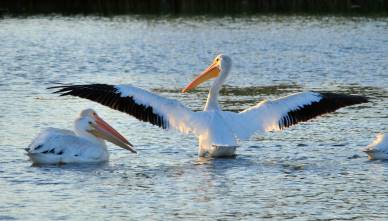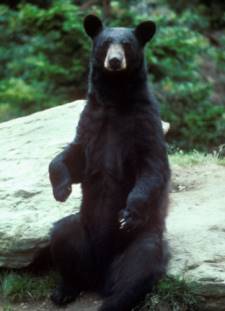Wildlife Conservation

The White Pelican
Source: USFWS
Back to Animals
Protecting Animals in National Parks
One of the main ways that governments can help to conserve wildlife is to help protect wildlife habitats. Many governments have national parks where activities like hunting, mining, farming, and fishing are illegal. Most of the time development is prevented or very limited in these areas.
The first national park was Yellowstone National Park in the United States. President Ulysses S. Grant made it a national park in 1872. Today there are 58 national parks covering over 200,000 square kilometers of land in the United States. Throughout the world, there are over 100 countries that together protect over 1000 national parks and wildlife preserves.
Captive Breeding
In some cases, the habitats for certain species have been destroyed to the point where the animals can no longer survive in the wild. Fortunately, in some cases zoos have maintained the species and helped them to grow their population while in captivity.
One example of this is the Arabian oryx. In the early 1970s the oryx was nearly hunted to extinction. The last few oryx were saved by zoos and the animal was declared extinct in the wild. Through captive breeding programs the population was increased. Some oryx were released back into the wild. In 2011 the Arabian oryx was the first animal that was successfully moved from the "extinct in the wild" list to the "vulnerable" list.

The American Black Bear
Source: USFWS
An important part of protecting animals involves keeping track of animal populations. This helps scientists to know if the population is growing or shrinking. Scientists use a number of methods to try and understand animal populations.
Sometimes scientists track populations by having a number of people go out into an area and look at physical evidence such as animal tracks, dens or burrows, and feeding sites. This method can take a lot of people and time, but sometimes it is the only option available. It also can be dangerous when trying to track animals like tigers or rhinos.
Another way to track animals is to tag them with transmitters. With transmitters scientists can track animal movements including migration patterns. Today's technology has allowed transmitters to be much smaller. They can be placed under an animal's skin or even swallowed. Some advanced tracking technology uses GPS and allows scientists to track the exact location of the animal.
Remote control cameras are also used to track animals. These cameras sit in a clear weatherproof case and are often attached to a tree near a feeding site or wildlife trail. They use motion sensors which snap pictures of animals as they walk by.
Laws to Protect Animals
Another way that governments can help in protecting animals is with laws making it illegal to kill or harm endangered species. There are many laws and international treaties that protect animals. People who hurt or kill these protected animals can go to jail for a long time and pay heavy fines. Unfortunately, there are still some countries that have not signed the treaties or do not enforce the laws with heavy penalties.
Interesting Facts About Wildlife Conservation
- There are more than 1,000 endangered species worldwide.
- Around 2 million square miles of the planet is protected. This sounds like a lot, but is only 3% of the total land area.
- The world's only true wild horse, the Przewalski's horse, became extinct in the wild. However, captive breeding and reintroduction to the wild has moved the horse back to the endangered list.
- Three of the strongest conservation laws include the Endangered Species Act, the Convention on International Trade in Endangered Species, and the Rhinoceros and Tiger Conservation Act.
- A kilogram of elephant ivory can sell for as much as $1000. Rhino horns sell for even more.
- The bald eagle was nearly wiped out by the pesticide DDT. After DDT was banned, the population increased and it was removed from the endangered list in 2007.
More on endangered species:
Amphibians in Danger
Endangered Animals
How Animals Become Extinct
Wildlife Conservation
Zoos
Back to Animals

